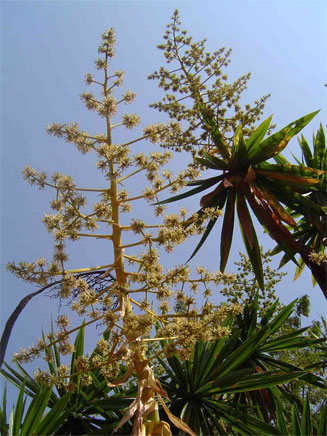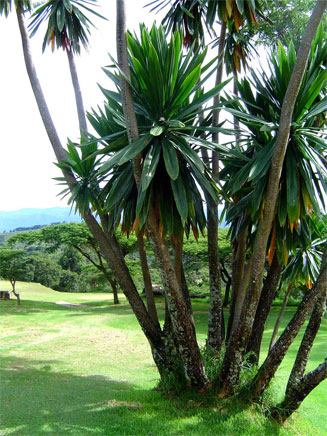Dracaena steudneri (Northern
large-leaved dragon-tree)
Life
> eukaryotes >
Archaeoplastida >
Chloroplastida
>
Charophyta > Streptophytina > Plantae (land plants)
> Tracheophyta (vascular plants) > Euphyllophyta > Lignophyta (woody plants)
> Spermatophyta (seed plants) > Angiospermae (flowering
plants) > Monocotyledons > Order: Asparagales
> Family: Asparagaceae > Genus:
Dracaena
 |
 |
Dracaena
steudneri, National Botanic Garden, Zimbabwe. [photo Bart Wursten ©,
Flora
of Zimbabwe] |
Dracaena steudneri, Leopard Rock Golf
Course, Zimbabwe. [photo Bart Wursten ©,
Flora
of Zimbabwe] |
A tree that grows in the understorey and on the
margin of evergreen forests in eastern and central Africa, extending
as far south as eastern Zimbabwe, and Mozambique.
Identification
- A tree 3-25 m high with a single stem up to 45 cm in
diameter, branching terminally.
- Leaves are formed in rosettes at the end of branches and are
40–130 cm long and 4–16 cm wide
- Flowers are in sprays ranging from 30-200 cm long. Each
individual flower is white, greenish white or cream and is 11-18
mm long. Flowers open only at night and emit a sweet smell.
- The fruit is 12-30 mm in diameter, and turns from green to
black with intermediary colours including dark purple, red and
blackish red.
Distribution and habitat
Eastern and Central Africa, extending from
Ethiopia in the north to Zimbabwe and Mozambique in the south.
Occurs as an understorey tree in evergreen forest and also grows
along forest margins.
Ecological interactions
- As flowers only open at night and emit a sweet smell, they
are likely to be pollinated by moths, but there is no evidence
of this.
- As with other species of Dracaena, fruit are likely
to be eaten by birds (no specific information available).
See also Ecological Interactions under
Dracaena.
Phenology
- Flowers in August.
- In fruit from October to December.
Uses
- Cultivated in gardens because of its interesting shape.
- In tropical Africa the leaves and roots are used to a small
extent for medicines.
- The leaves are sometimes used as a wrapping material.
References
- Mwachala, G. & Mbugua, P. 2007. Flora of Tropical East
Africa, as accessed from JStor (http://plants.jstor.org/flora/ftea009078).
- Palgrave, K.C. and Palgrave, M.C. 2002. Trees of Southern Africa. 3rd
Edition. Struik Publishers, Cape Town.
Text by Hamish Robertson |
